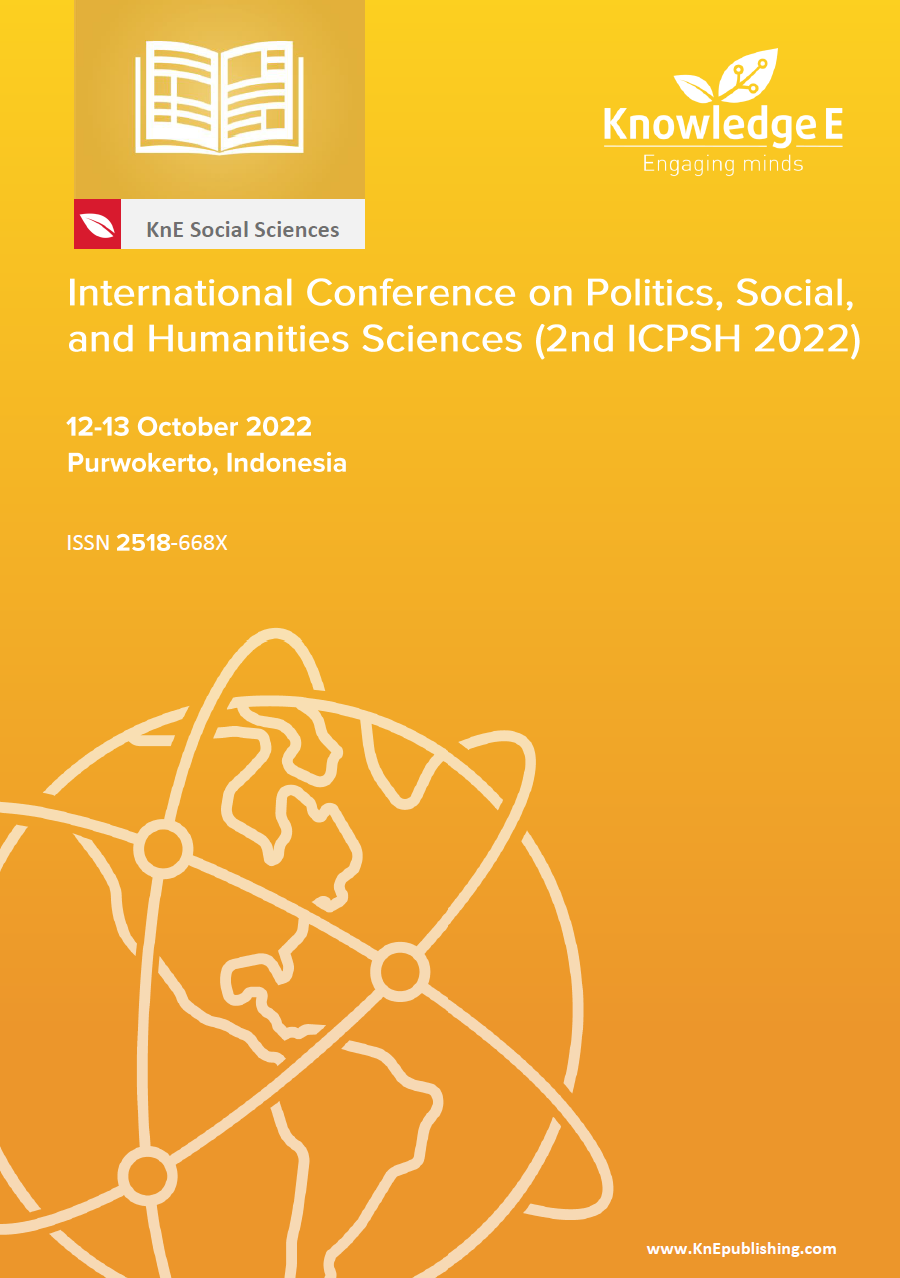Transformation of River Restoration Movement Network
DOI:
https://doi.org/10.18502/kss.v8i3.12839Abstract
A study on social network transformation of river restoration movement is very important as it is related to the network’s ability of adapting to various changes and a movement’s sustainability. This research aims to reveal the history of movement emergence, tactic, and strategy, process and procedure of social network establishment and social network transformation. An ethnographic approach was chosen by involving Komunitas Pemerti Kali Code (Code River Observer Community) as the main subject of current research. Data collection was conducted through live-in-society process for 2 months to conduct participant observation, in-depth interview and Focus Group Discussion. Data analysis was constructed using Mario Diani’s theory about social movement as a network. The result of research shows that the first factor is the emergence of problem and grievance about river contamination by rubbish and waste due to people’s poor literacy about river. The second one is movement strategy and tactic used in the form of structural and cultural approach to restore the river. The third is the process of creating social network based on shared idea, value, norm, collective identity, and interest related to the river. The fourth is social network experiencing transformation from spontaneity, institutionalization to autonomy phase as the attempt of adapting to and reconciling with the form of change to maintain the movement sustainability.
Keywords: River Restoration Movement, Movement Strategy, Social Network Establishment, and Social Network Transformation
References
Perini K, Sabbion P. Urban Sustainability and River Restoration. Urban Sustainability and River Restoration. 2017.
Rootes C. Environmental movements: From the local to the global. Env Polit. 1999;8(1):1–12.
Mertig AG, Dunlap RE. Environmentalism, new social movements, and the new class: A cross-national investigation. Rural Sociol. 2001;66(1):113–36.
Fisher JA, Brown K. Reprint of “Ecosystem services concepts and approaches in conservation: Just a rhetorical tool?” Ecol Econ. 2015;117:261–9.
Frascaroli F, Parrinello G, Root-Bernstein M. Linking contemporary river restoration to economics, technology, politics, and society: Perspectives from a historical case study of the Po River Basin, Italy. Ambio [Internet]. 2021;50(2):492–504. Available from: https://doi.org/10.1007/s13280-020-01363-3
Eden S, Tunstall SM, Tapsell SM. Translating nature: River restoration as nature - culture. Environ Plan D Soc Sp. 2000;18(2):257–73.
Maryono A. Kajian Lebar Sempadan Sungai (Studi Kasus Sungai- Sungai di Provinsi Daerah Istimewa Yogyakarta). Din Tek SIPIL [Internet]. 2009;vol 9 nomo( Januari):55–66. Available from: https://publikasiilmiah.ums.ac.id/bitstream/handle/123456789/230/_9_%20Agus%20Maryono-UGM%20_ok_.pdf?sequence=1
Club TS, Author KR, Source TW, Press C, Science F, Url S. Grassroots in Action : The Sierra Club ’ s Role in the Campaign to Restore the Kissimmee River Author (s): Theresa Woody Source : Journal of the North American Benthological Society , Vol. 12 , No . 2 ( Jun ., 1993 ), pp . Published by : University of . 2016;12(2):201–5.
Clark BT. River restoration in the American West: Assessing variation in the outcomes of policy change. Soc Nat Resour. 2009;22(5):401–16.
Hinck J. The Bronx River Alliance : A Model Community Action Organization And an Internship in Development. 2013;(2010).
Suharko S, Kusumadewi CDM. Organisasi Masyarakat Sipil dan Restorasi Sungai: Studi pada Gerakan Memungut Sehelai Sampah di Sungai Karang Mumus di Kota Samarinda. J Sosiol Reflektif. 2019;14(1):81.
Lee A. Southern Green Revolution : Urban Environmental Activism in How does access to this work benefit you ? Let us know ! Southern Green Revolution : Urban Environmental Activism in Kaohsiung , Taiwan. 2007;
Sneddon C, Magilligan FJ, Fox CA. Peopling the Environmental State: River Restoration and State Power. Ann Am Assoc Geogr. 2022;112(1):1–18.
Diani M, Bison I. Organizations, coalitions, and movements. Theory Soc. 2004;33(3– 4):281–309.
Della Porta D, Diani M, Della Porta D, Diani M. Introduction. The Oxford Handbook of Social Movements. 2015. 1–31 p.
Diani M. Networks and Social Movements: A Research Programme. Soc Movements Networks Relational Approaches to Collect Action. 2003;
Hammersley M. Ethnography: problems and prospects. Ethnogr Educ. 2006;1(1):3–14.
Plows A. Social Movements and Ethnographic Methodologies: An Analysis Using Case Study Examples. Sociol Compass. 2008;2(5):1523–38.
Gibbons JA, Hammersley M, Atkinson P. Ethnography: Principles in Practice. Vol. 15, Contemporary Sociology. 1986. 451 p.
Lincoln NKD, S. Y. The handbook on Qualitative Research. Vol. 5, Sage Publications. 2017. 1688 p.
2Khudori D. Menuju Kampung Pemerdekaan. Yayasan Pondok Rakyat; 2002.
Rahayu T, Sudaryono, Baiquni M. Evaluasi Program Penataan dan Rehabilitasi Permukiman Kumuh Studi Kasus Kawasan Bantaran Sungai Code Bagian Utara Yogyakarta. Mns dan Lingkung [Internet]. 2003;10(2):53–62. Available from: http://jpe-ces.ugm.ac.id/ojs/index.php/JML/article/view/334/262
Seftyono C. Pembangunan berbasis Waterfront dan Transformasi Konflik di Bantaran Sungai : Sebuah Pemikiran Awal. 2012;16:74–83.
Gross M. Science Studies 2/2002 New Natures and Old Science: Hands-on Practice and Academic Research in Ecological Restoration. Sci Stud (St Bonaventure). 2002;15(2):17–35. [25] Maryono A. Restorasi Sungai. Gadjah Mada Press; 2007.
Sofjan D, Haba J, editors. Dunia Kali Code. Sekolah Pasca Sarjana Universitas Gadjah Mada, Yogyakarta; 2018.
Lombard D. Nusa Jawa; Silang Budaya Batas-Batas Pembaratan. Gramedia Pustaka Utama, Jakarta; 2005.
Passy F. Social Networks Matter: But How? In: Diani M, McAdam D, editors. Oxford University Press Inc, New York; 2003. p. 21–48.
Fox CA, Reo NJ, Turner DA, Cook JA, Dituri F, Fessell B, et al. “The river is us; the river is in our veins”: re-defining river restoration in three Indigenous communities. Sustain Sci. 2017;12(4):521–33.
Kaiser NN, Feld CK, Stoll S. Does river restoration increase ecosystem services? Ecosyst Serv. 2020;46(March).
Fernadez RM, McAdam D. Social Networks and Social Movements : Multiorganizational Fields and Recruitment to Mississippi Freedom Summer Author ( s ): Roberto M . Fernandez and Doug McAdam Published by : Springer Stable URL : https://www.jstor.org/stable/684338 Social Networks an. Sociol Forum. 1988;3(3):357–82.
Miller B. Castells’ The City and the Grassroots: 1983 and today. Int J Urban Reg Res. 2006;30(1):207–11.
Diani M. Social Movement Networks Virtual and Real. Information, Commun Soc. 2000;3(3):386–401.
Tarrow SG. Power in Movements. New York: Cambridge University Press; 2011.
Seftyono C. Dilema Implementasi Kebijakan Pembangunan Bantaran Kali Code-Yogyakarta. 2016;( January 2013):1– 114. Available from: https://www.researchgate.net/publication/ 284425623_Dilema_Implementasi_Kebijakan_Pembangunan_Bantaran_Kali_Code- Yogyakarta
Gerlach LP. The structure of social movements: Environmental activism and its opponents. In: Networks and netwars: The future of terror, crime, and militancy [Internet]. RAND, Pittsburg; p. 289–310. Available from: http://books. google.com/books?hl=en&lr=&id=VKFMTDnapl4C&oi=fnd&pg= PA289&dq=The+structure+of+social+movements:+Environmental+activism+ and+its+opponents&ots=jDfGI7NkG9&sig=H-Rzw-f1Zzl2iBr5fRfG2zo-iUo

